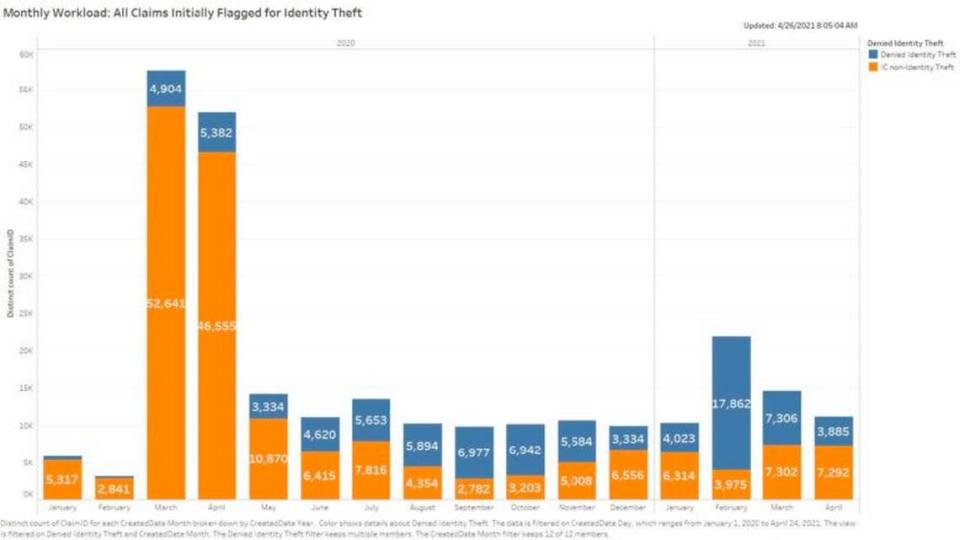Fraudsters with stolen IDs flood Idaho agency with unemployment claims, force delays
When COVID-19 hit Idaho in March 2020 and put thousands of people out of work, fewer than 10% of unemployment claims were fraudulent.
In February of this year, those numbers were upside down. Just 18% of claims were deemed legitimate, or about 4,000 claims out of nearly 20,000, according to numbers provided by the Idaho Department of Labor.
“The unemployment insurance program has really been targeted by fraudsters,” said Jani Revier, the department director. “Because of all the federal dollars, there’s a lot more money in it right now, and the relaxed eligibility requirements really opened the door for fraudsters. There are crime rings international and domestic that are trying to exploit unemployment insurance systems to get money.”
Scammers who have obtained personal identification information such as Social Security numbers from large-scale data breaches have used that information to fill out unemployment claims in various states, sometimes through the use of bot software. Revier said state agencies are working with the FBI and the other federal officials to investigate the crimes, and staffers reviewing claims at the Idaho Department of Labor keep an eye on red flags such as IP addresses originating from overseas locations.
“You’ve got professional hackers that know how to cover their identities, so it’s hard sometimes to trace it back,” Revier said. “… It’s easy money if they can get a payout.”

The problem is so widespread that the U.S. Department of Labor issued guidance to unemployment agencies about how to prevent fraudulent claims from being approved and launched a website to assist victims of unemployment insurance identity theft.
As the number of fraudulent claims started ticking up over the summer last year, Department of Labor staffers started calling individuals who had filed initial claims for unemployment to verify their identity. Revier said that practice soon became overwhelming for the staff, and the department secured a contract with ID.me, an identity verification program that has been implemented in 22 states, including California, Ohio, Georgia and Florida.
But the company is less than a decade old and was still considered a start-up until recently. With the huge increase in demand for the company’s services, Revier said some claimants have long wait times before their identities are verified, and claims aren’t paid out until verification is complete.
“Earlier (in April) some of the big states like California and Colorado and Florida sent all of their claimants through ID.Me instead of just initial claimants, and it really slowed things down,” Revier said.

The company is working to hire more staff and open a call center. “It’s not a perfect solution; we do realize that it is slowing people down in some cases.”
But Revier said since the department adopted the system, fraudulent claims have significantly decreased, from nearly 80% fraudulent claims in February to about 35% in April.
“We also recognize that everyone doesn’t have the same technological capabilities across the state,” Revier said, acknowledging some people don’t have the same access to Wi-Fi and internet connectivity across Idaho. “So in those cases we encourage people to call our office and ask for a supervisor so we can triage and figure out the appropriate way to get them through this system. We do have alternative means to get folks’ identity verified if they truly can’t complete the ID.Me process.”
Claimants struggling with long wait times for identity verification
One of those people is Jake Englehorn, a self-employed marketing and public relations professional in Boise. He said he felt “lucky” to have only waited three weeks to be verified by the program versus months he’s heard other people have waited.
The service requires some claimants to visit over video with a “trusted referee” from ID.Me if their verification materials are unreadable or if pictures aren’t taken in well-lit areas. Englehorn said the Idaho Unemployment Group on Facebook has been filled with stories of people waiting hours to visit with a referee.
“There’s some stories of people on there who have appointments at 3 p.m., so they rearrange their whole schedule and then have seven hours of waiting,” Englehorn said.

Others are held up by even simpler problems. Marcia Pilgeram, a travel agent who lives in Sandpoint, said she thought she had completed the verification process, but she received a notice in the mail from the Department of Labor letting her know that she could become ineligible if she didn’t complete one more step. After all that, it was over a month before she received another payment.
Englehorn said it seems that the state implemented the system to discourage people in the unemployment system from continuing to file, and some people have given up because it’s “not worth it” to go through so many hoops.
Leah Reeder, a spokesperson at the Idaho Department of Labor, said 80% to 90% of the claimants who have been required to verify their identities haven’t experienced problems. She said the only intention is to prevent fraud.
“It’s designed to prevent people from filing for unemployment insurance using a stolen identity, which is one of the big methods people are using to defraud the system,” Reeder said. “If a claimant is having difficulty, they can contact us.”
Englehorn said calling is its own waiting game, with sometimes hour-long waits and confusion from those he does talk to.
“It seems like the people that I have talked to at the Department of Labor or ID.Me, they seem like great people. It seems like the systems have really failed them,” Englehorn said. “Their hands seem to be tied. It seems like they’re doing the best they can. It’s just an impossible system.”
Reeder said many staffers who answer phones at the Department of Labor are newer, but there is a quality control process of reviewing notes from calls to make sure questions are appropriately answered, and the average wait time is less than 20 minutes with the exception of high-volume days like Mondays.
If a caller thinks a question isn’t being answered or if there’s confusion, Reeder recommends asking to speak to a supervisor.
If someone is having difficulty with ID.Me specifically, Reeder said the company has representatives available to help at any time day or night, seven days a week.

 Yahoo Movies
Yahoo Movies 
